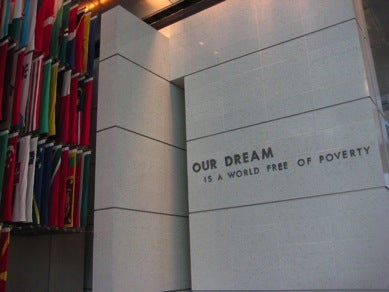 On entering World Bank headquarters in Washington, DC, the words “Our Dream is a World Free of Poverty” are prominently displayed on a wall near the main entrance. This April, the Bank moved one step closer to realizing this dream by establishing a set of challenging goals to ‘galvanize international and national efforts to end extreme poverty worldwide within a generation and to promote shared prosperity.’ The goals focus on decreasing the percentage of the world’s population living on less than $1.25 a day to no more than 3 percent by 2030, and promoting income growth amongst the bottom 40 percent of the population in each country (
read more).
On entering World Bank headquarters in Washington, DC, the words “Our Dream is a World Free of Poverty” are prominently displayed on a wall near the main entrance. This April, the Bank moved one step closer to realizing this dream by establishing a set of challenging goals to ‘galvanize international and national efforts to end extreme poverty worldwide within a generation and to promote shared prosperity.’ The goals focus on decreasing the percentage of the world’s population living on less than $1.25 a day to no more than 3 percent by 2030, and promoting income growth amongst the bottom 40 percent of the population in each country (
read more).
To tackle poverty at this scale, we need to explore new ways of doing things. While not a silver bullet, we think information and communication technologies (ICTs) can be a force multiplier in this fight.
Take digital identity, for example. The World Bank recently hosted Nandan Nilekani, chairman of the Unique Identification Authority of India and co-founder of Infosys, who presented a program to provide digital identities to India’s 1.2 billion residents. The Aadhaar ("foundation" in Hindi) program seeks to capture a biometric profile (finger prints, iris scan and photograph) and assign a unique 12-digit ID number for each resident. World Bank President Jim Yong Kim and Chief Economist Kaushik Basu lauded the program, calling it a ‘poverty killer’ and a ‘game changer’.
Digital identities can make a huge difference to the lives of the poor. For example:
- Financial access: Poor people typically have small, volatile incomes, so they need to build savings as an insurance against income shocks arising from unanticipated incidents such as illness, loss of employment, and crop failures. Mobile phones and ATMs can provide increased access to banking services, but many poor people are not benefiting due to their lack of a registered identity. A unique digital identity can make it easier for them to access micro-payments, micro-credit, micro-insurance, micro-pensions, and even micro-mutual funds which are increasingly available.
- Preventing fraud: Rajiv Gandhi, a former prime minister of India, once famously stated that only 15% of the benefits which were meant for the poor actually reached them. In India, an audit of muster rolls of the National Rural Employment Guarantee Scheme found 8.6% ghost beneficiaries, 23.1% ghost person days, and only 61% of wage payments reaching eligible workers (read more). Digital identities can help plug such leakages and prevent fraud. In Nigeria, for instance, biometric audits resulted in a reduction of 40% in the number of federal pensioners (read more).
- Enhancing women’s incomes: According to the ILO, women contribute 70% of working hours globally, but receive only 10% of income flows (read more). 30 out of the bottom 40% of the population in developing countries are likely to be women. Enhancing women’s incomes is recognized as one of the most effective anti-poverty programs. The money transferred to them gets spent on nutrition, education, and clothing for the family, directly impacting poverty. A digital identity can ensure that benefits meant for women, such as conditional cash transfers, actually reach women.
To mitigate the privacy-related problems, the Aadhaar program has incorporated explicit privacy protection measures. For example, information is collected for essential data fields only, such as name, date of birth, and gender. No information is collected on religion, caste, community, class, ethnicity, income or health. Only categorical responses (‘yes’ or ‘no’) may be provided from the Aadhaar database in response to any queries on identity. Also, the database is not linked to any other databases or to information held in other databases.
Digital identities are one way in which ICTs can help fight poverty. Our next blog post will look at other ICT solutions that can contribute to poverty reduction.



Join the Conversation